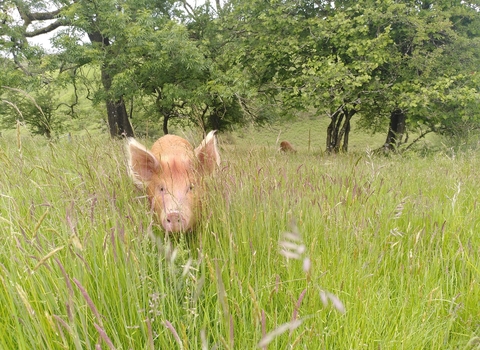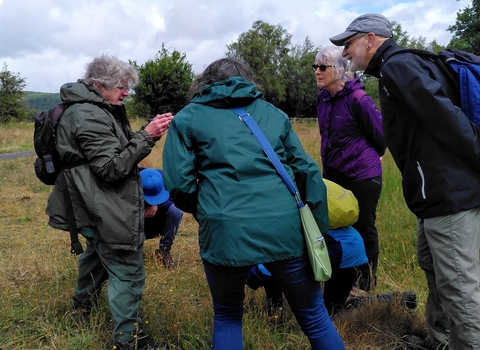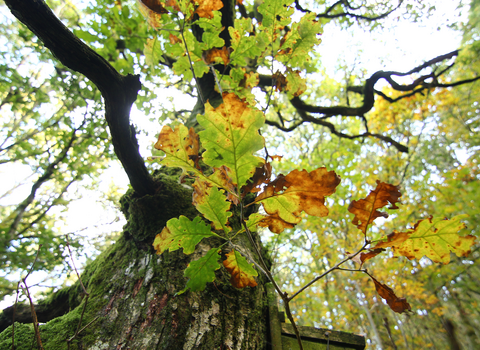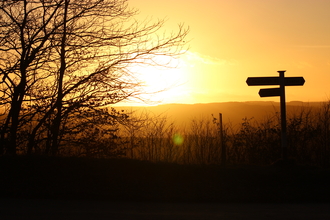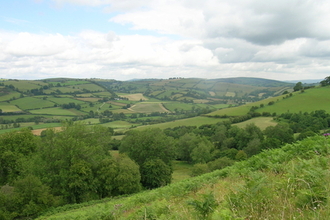Wilder Pentwyn is a project funded for two years by The National Lottery Heritage Fund, thanks to National Lottery players. The project aims to protect, restore and share natural heritage knowledge at Pentwyn Farm. It enables Radnorshire Wildlife Trust to forge ahead with its 30-year vision for a Wilder Pentwyn, to transform the land and work with communities and landowners to deliver nature recovery at scale.
Wilder Pentwyn Animation (English Captions) (https://youtu.be/Z749LoDu2Yw?feature=shared)
Animation produced by Andrew Dixon
Project Aims
Project Purposes
- Design and deliver a series of landowner engagement events
- Carry out a series of ecological surveys on the various habitats across the site
- Create a volunteer management plan
- Design and deliver a series of project engagement workshops
- Carry out on-site habitat and species restoration and development work
- Create a site management and maintenance plan
- Develop and deliver a digital engagement plan
- Run community consultation sessions
Project Progress
The Wilder Pentwyn Project started on 1st September 2023, and finishes on the 31st August 2025. The team has been busy delivering habitat work, community engagement events, digital engagement, infrastructure improvements, gathering baseline data and carrying out further biological monitoring, as well as developing relationships with the local community and with other organisations.
We have a well established volunteer group and local farm cluster group, as well as a variety of events through which you can visit the site, learn about the project, and get involved. Get in touch with the Pentwyn Project Officer Chloe via chloe@rwtwales.org if you would like to become a volunteer or join the farm cluster group. And keep an eye on the RWT events page!
By the end of the project we will have an indoor 'classroom' space which we will be able to utilise for school visits, volunteer sessions, community events, corporate groups, and more. We look forward to welcoming the local community for an event to celebrate the classroom opening!
So far...
Biological Monitoring
Some baseline data was gathered before the start of the Wilder Pentwyn project. This included soil sampling, carbon data, environmental DNA (soil invertebrates and fungi, and freshwater insects and vertebrates), a Phase 1 habitat survey, and some initial bird, butterfly and botany surveys.
Since the start of the project, our dedicated volunteer team have carried out a huge amount of data collection. This has included winter bird surveys, breeding bird surveys, butterfly surveys, bumblebee surveys, moth trapping, hedgerow surveys, Purple hairstreak surveys, grazing impact surveys, botanical surveys, and putting out trail cameras. Our Data Mapping Trainee, Thea, carried out a UK Habitat Classification and produced a brilliant map. Pentwyn Volunteer, Martyn, has produced a base layer GIS map of Pentwyn showing all of the survey transect routes. In addition, he also compiled a summary report of the Pentwyn butterfly data from the 2022/2023 data, which you can view below in the 'Reports' section. Volunteers will also be producing summary reports for bird, bumblebee and moth data.
In addition, local ecologists have been contracted to carry out a detailed botanical survey, a Hymenoptera survey (bees, wasps and sawflies), and to monitor small mammals using footprint tunnels and dormouse tubes.
Forestry Work
Forestry work initially began on the South of Pentwyn Farm, on a wood which is designated under ‘Plantations on Ancient Woodland Sites’. The aim of the work is to restore the ancient woodland site, through the phased removal of the non-native Larch and Sitka spruce, whilst minimising damage to the soils, floral hotspots, and native trees, especially any veteran and ancient specimens. A local contractor was hired to remove every sixth row and thin the adjacent two rows, leaving the middle one intact for wind stability. The harvesting work was completed in February 2024, whereas the extraction of the timber off the site was carried out in June when the ground was drier, to minimise soil compaction.
The next thinning intervention will take place on the South plantation in 4-5 years. This gradual approach to removing the non-native species and restoring the site with native broadleaf species is called Continuous Cover Forestry. The approach aims to create an irregular and diverse forest structure, consisting of different species and ages of tree. It produces timber in a sustainable way, whilst retaining the canopy.
We are aiming to take the same approach on the North plantation at Pentwyn during winter 2024/25, however we are awaiting advise from The Woodland Trust as wind throw may be a bigger problem when thinning this woodland.
Tree Planting
Enrichment planting of shade tolerant broadleaf species was carried out by volunteers in the South plantation in the gaps created through the forestry thinning work. In addition to this, three new hedges were planted at Pentwyn during the 2023/24 winter.
After approval from the active Graziers on Beacon Hill Common; 200 trees were planted using 'sabre' or 'no fence' tree planting techniques, just outside of the Pentwyn boundary on the land around the River Lugg (Crown Estate land on one side, RWT-owned nature reserve, Cnwch Bank, on the other side). The technique involves planting trees at 90 degrees to a steep slope, helping to keep the vulnerable leading shoots as far out of reach from grazing as possible, and avoiding the use of any tree guards or fencing. The trees are 1 - 1.5 metres tall, and pot grown to increase success.
The sabre planting technique will be implemented to plant trees in suitable locations at Pentwyn Farm during winter 24/25. In addition, some trees will be planted with no guards or fencing in amongst bracken or gorse to act as protection. Other trees will be planted at low density to create wood pasture habitat, using cactus tree guards to protect them from our grazing livestock.
Plans are also underway to carry out a woodland creation project as part of the Woodland Carbon Code. This will involve planting native broadleaf trees in suitable locations at Pentwyn (based on historical data of where woodland used to be, suitable habitat conditions, and considerations around habitat connectivity). This would allow us to sequester carbon and sell the carbon credits to a company wanting to offset their UK emissions, creating an important income stream for us. However, it is important that we do this with proper consideration for the 'right tree, right place' so that habitat creation is still the driver, also ensuring that the company offsetting is legit and ethical, avoiding greenwashing.
Hedgerow Management
We have some wonderful hedgerows at Pentwyn, consisting of hazel, hawthorn, blackthorn, elm, and some lovely ancient apple trees. Many of our hedges at Pentwyn are simply being left to widen and tumble down, perhaps in time becoming less of a neat hedge and instead a scrubby area.
However, we also decided to trial a method called mechanical or wildlife hedgelaying on two unmanaged and gappy hedges consisting of mature trees. Wildlife hedgelaying was developed in 2008 by farmers in Aylesbury, using a chainsaw and tractor to carefully pleach and lay the big stems without removing any material whatsoever. A big part of our vision is to experiment with new techniques and then share that learning. Traditional hedge laying and rural skills are very valuable, but it is generally not something that is widely carried out in the landscapes of mid Wales anymore due to financial and time restraints. For landowners that don't have the time or are not willing to spend the money on traditional hedgelaying, this is a quick and affordable option which we would promote rather than hedges being flailed. Sure, the hedge looks like a hurricane has gone through it in its first year, but it will regenerate from the crown and the base after the second year and will be back as a tall, broad, and thick hedgerow providing a multitude of microhabitats for birds, insects, and small mammals. Wildlife doesn’t thrive in tidy, artificial environments, so we have left any snapped stems in the hedge to increase the important deadwood resource for saproxylic beetles and add to the nutrient cycling of the soil. As a priority, we want to conserve the Welsh genetics of these old hedgerow trees, being the best locally adapted trees to pests and diseases and being more resilient to the effects of changing climate, rather than bringing in planting stock from other regions.
You can read more about the technique in the guest blog on our website: Mechanical hedgelaying for wildlife | Radnorshire Wildlife Trust (rwtwales.org)
Wetland Creation and Natural Flood Management
We’ve been working hard to finalise plans for wetland expansion across a 6.3-hectare area on the South of Pentwyn through the creation of scrapes and ponds in the fields as well as leaky wood barriers in the watercourse, which will put back lost open water and give space for amphibians and insects such as Broad-bodied chaser dragonfly. We are still in the process of obtaining permissions for this work, but in the meantime a contractor has been booked to locate and break land drains in some fields, to reverse previous human intervention to hold back rainwater and instead create more natural wet grassland and marsh habitat.
Our Wilder Lugg Officer has installed the first of a number of leaky dam's on the North side of Pentwyn, with the aim of causing disruption and slowing the flow of water in high rainfall events. We hope to showcase the importance of natural flood management techniques. In addition, Dan is creating a number of scrapes across the North side of Pentwyn, which will produce wet habitat, but also have benefits for our livestock by providing more access to water.
Meadow Creation
In early 2024, we decided to experiment by spreading dry yellow rattle hay and wildflower seeds on patches of bare ground created by the pigs. The pigs rootle, helping to aerate the soil, and they create areas of bare ground, which is needed for seeds to germinate.
The main focus of meadow creation work has been green hay spreading, with the aim of increasing the botanical diversity of our grasslands. Three local landowners kindly agreed to cut their meadows and provide us with green hay (freshly cut and spread later that same day). Botanical surveys were conducted at their meadows by volunteers in the Spring so that we knew what seed stock we would be introducing at Pentwyn. In some cases, a landowner was able to cut and bale the hay themselves, whereas in other cases our Assistant Reserves Officer cut the hay with a powered scythe and our Tuesday Volunteer Group worked hard to rake it into bags and load it for transport! Then, more volunteers were ready at Pentwyn to spread the green hay by hand or using pitch forks.
Species Reintroductions
We have developed a plan for spring 2025, to reintroduce 10 species of flora and one species of lichen, all of which have declined significantly in Mid-Wales. A local expert in rare plant recovery projects visited Pentwyn Farm and identified suitable habitats for introducing a number of exciting species: Deptford pink, Melancholy thistle, Common butterwort, Wood bitter-vetch, Brecon dandelion, Spreading bellflower, Mountain pansy, Globeflower, Annual knawel, Tubular water-dropwort, and Tree lungwort. Four of these species are listed as a 'species of principle importance to Wales' under Section 7 of the Environment (Wales) Act 2016. We are excited to trial this within a rewilding project, without fencing the plants off and separating them from our extensively grazing livestock. Our goal is to see these plants spread naturally, aided by the gentle disturbance from our livestock and therefore demonstrating the benefits of rewilding. Also, increasing acceptance of dynamic, shifting habitats and wildlife as well as process led approaches rather than prescriptive targets.
We may also consider Water vole reintroductions in the future, but initially need to carry out a feasibility study.
The Wilder Pentwyn Project came to and end in October 2025. Take a took at this project round up video! A huge thank you to everyone who mad this possible, kickstarting our 30 year vision for the site.
Audio Tour
Not had a chance to visit the site yet? You can experience some of the magic that Pentwyn has to offer through this immersive and bilingual audio tour available to watch for free on Bandcamp: listen here!

The Wilder Pentwyn project is made possible with The National Lottery Heritage Fund, thanks to National Lottery players.

